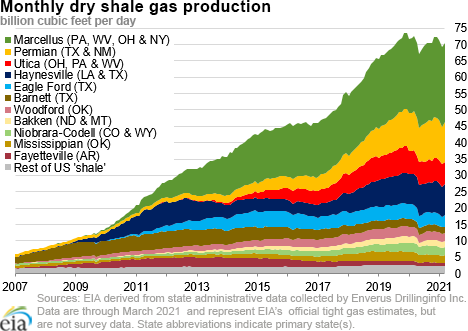In the News:
Net withdrawals from working gas stocks exceeded the five-year average during the 2020–21 heating season
Working natural gas in underground storage facilities in the Lower 48 states totaled 1,778 billion cubic feet (Bcf) as of March 31, 2021—the end of the winter heating season that began on November 1, 2020—and was 1.4% lower than the five-year average (2016-20), according to EIA’s Weekly Natural Gas Storage Report released on April 8. Net withdrawals from working natural gas inventories during the 2020–21 heating season exceeded the five-year average by 10.6%.
The key driver to changes in working natural gas stocks during the winter 2020–21 heating season was a sustained period of colder-than-normal temperatures throughout much of the Lower 48 states from late January to mid-February. A sustained cold snap contributed to high residential- and commercial-sector demand for space heating, and freeze-offs at producing wells that reduced natural gas production led to large withdrawals from storage fields.
Net withdrawals from underground storage facilities in the Lower 48 states during February totaled 778 Bcf—the largest draw for any February on record since 2011—and exceeded the five-year average for February by 328 Bcf. The net withdrawals during February represented about 37% of all withdrawals from natural gas storage during the 2020-21 heating season, compared with 24% over the previous five heating seasons. In February 2021, population-weighted heating degree days (HDDs) were 13% higher than normal, which drove the higher-than-normal withdrawals. Total February natural gas demand (including exports and pipeline losses) averaged about 123 billion cubic feet per day (Bcf/d), according to IHS Markit.
At the start of winter heating season (November 1) working natural gas stocks exceeded the five-year average by 178 Bcf and came near record-high levels. This surplus grew to 285 Bcf by December as a result of mild early-winter temperatures. Colder-than-normal temperatures in February resulted in the first Lower 48 states’ stock deficit to the five-year average since November 2019.
See EIA’s Natural Gas Storage Dashboard for more updates on the storage market conditions.
Overview:
(For the week ending Wednesday, April 14, 2021)
- Natural gas spot prices rose at most locations this report week (Wednesday, April 7 to Wednesday, April 14). The Henry Hub spot price rose from $2.38 per million British thermal units (MMBtu) last Wednesday to $2.60/MMBtu yesterday.
- At the New York Mercantile Exchange (NYMEX), the price of the May 2021 contract increased 10¢, from $2.520/MMBtu last Wednesday to $2.618/MMBtu yesterday. The price of the 12-month strip averaging May 2021 through April 2022 futures contracts climbed 9¢/MMBtu to $2.835/MMBtu.
- The net injections to working gas totaled 61 billion cubic feet (Bcf) for the week ending April 9. Working natural gas stocks totaled 1,845 Bcf, which is 12% lower than the year-ago level and 1% more than the five-year (2016–2020) average for this week.
- The natural gas plant liquids composite price at Mont Belvieu, Texas, fell by 49¢/MMBtu, averaging $7.10/MMBtu for the week ending April 14. The prices of natural gasoline, propane, butane, and isobutane fell by 2%, 11%, 8%, and 8%, respectively, reflecting high inventory levels. EIA’s Weekly Petroleum Status Report reported total NGPL stocks above the 5-year range and a propane stock build for the second week in a row. The price of ethane rose by 4% as demand for ethane in the petrochemical sector returns to average levels after a February winter storm shuttered production at petrochemical plants along the Gulf Coast.
- According to Baker Hughes, for the week ending Tuesday, April 6, the natural gas rig count increased by 2 to 93. The number of oil-directed rigs remained constant at 337. The total rig count increased by 2, and it now stands at 432. The total rig count has increased for 4 weeks in a row, and is now 30 rigs higher than the reported March 9 total.
Prices/Supply/Demand:
Prices in most markets rise as mixed temperatures across the country result in higher-than expected heating and cooling demand. This report week (Wednesday, April 7 to Wednesday, April 14), the Henry Hub spot price rose 22¢ from $2.38/MMBtu last Wednesday to $2.60/MMBtu yesterday.
With mixed regional weather, Midwest prices rise in response to elevated heating and cooling demand. At the Chicago Citygate, the price increased 16¢ from $2.40/MMBtu last Wednesday to $2.56/MMBtu yesterday after dropping to a weekly low of $2.38/MMBtu last Friday. The Natural Gas Intelligence Midwest Regional average rose 18¢, from $2.32/MMBtu last Wednesday to $2.50/MMBtu yesterday, just 1¢ below the weekly high set on Tuesday. IHS Markit reports increased natural gas demand in the Midwest for both electricity generation (associated with increased air conditioning demand) and for residential/commercial demand (associated with increased space heating). The increased demand was the result of mixed weather across the region. Temperatures in Detroit reached 77°F on Thursday, 21°F above normal, and remained elevated through Tuesday. To the west, temperatures in Des Moines, Iowa, averaged in the low-50’s for most of the report week, hovering within 2°F above or below normal, before falling to 45°F on Tuesday and 42°F yesterday, 6°F and 9°F below normal, respectively.
Prices in California increase in response to higher prices at supply hubs and maintenance outages. The price at PG&E Citygate in Northern California rose 19¢, up from $3.55/MMBtu last Wednesday to a weekly high of $3.74/MMBtu yesterday. The PG&E price increase was less than the increase at Malin, Oregon, the main supply hub into PG&E, which rose 22¢, from $2.46/MMBtu last Wednesday to $2.68/MMBtu yesterday.
The price at SoCal Citygate in Southern California increased 75¢, more than in any other major market this week, from $3.13/MMBtu last Wednesday to $3.88/MMBtu yesterday. SoCalGas reported planned and unplanned capacity constraints at both the Honor Rancho and Playa del Ray natural gas storage fields, reducing withdrawal capacity by approximately 680 million cubic feet per day (MMcf/d). The Honor Rancho field is expected to return to service today, and the return of 135 MMcf/d of deliverability from the Playa del Ray field is yet to be determined. In addition, maintenance on the El Paso Natural Gas Company’s North Main Line, which links production in the Permian Basin with demand centers in Arizona and Southern California, reduced flows on the line by approximately 600 MMcf/d Tuesday, placing further upward pressure on prices along its delivery path.
Prices in the Northeast rise in response to higher demand. IHS Markit estimates Northeast natural gas consumption rose more than 3.3 billion cubic feet per day (Bcf/d) between last Wednesday, April 7, and Monday, April 12, as temperatures swung from well above normal last Wednesday to below normal on Monday at major consumption centers throughout the region. At the Algonquin Citygate, which serves Boston-area consumers, the price went up 44¢ from $1.92/MMBtu last Wednesday to $2.36/MMBtu yesterday. At the Transcontinental Pipeline (Transco) Zone 6 trading point for New York City, the price increased 40¢ from $1.85/MMBtu last Wednesday to $2.25/MMBtu yesterday. The lowest weekly prices at Algonquin Citygate and Transco Zone 6 were on Friday at $1.78/MMBtu and $1.67/MMBtu, respectively.
Prices in the Appalachia Basin-producing region followed prices in the consuming-regions higher. The Tennessee Zone 4 Marcellus spot price increased 23¢ from $1.74/MMBtu last Wednesday to $1.97/MMBtu yesterday. The price at Dominion South in southwest Pennsylvania rose 25¢ from $1.80/MMBtu last Wednesday to $2.05/MMBtu yesterday. Similar to the Northeast consuming regions, the lowest prices in the Appalachia Basin were reported on Friday, when Tennessee Zone 4 reached a low of $1.55/MMBtu and Dominion South dropped to $1.65/MMBtu.
The price in the Permian production region rises but by less than the Henry Hub price. The price at the Waha Hub in West Texas, which is located near Permian Basin production activities, averaged $2.24/MMBtu last Wednesday, 14¢/MMBtu lower than the Henry Hub price. Yesterday, the price at the Waha Hub averaged $2.40/MMBtu. The Waha Hub discount to the Henry Hub price increased to 20¢/MMBtu as pipeline congestion due to maintenance on the El Paso Pipeline reduced westbound flows out of the Permian Basin.
Imports from Canada decrease due to maintenance. According to data from IHS Markit, the average total supply of natural gas fell by 1.3% compared with the previous report week. Dry natural gas production decreased by 1.0% to 91.4 Bcf/d compared with 92.3 Bcf/d last report week. Average net imports from Canada decreased by 8.5% from last week, likely a result of planned maintenance on Westcoast Energy’s pipeline from the production region in British Columbia to the border with Washington State.
Residential and commercial consumption of natural gas declines sharply. Total U.S. consumption of natural gas fell by 3.6% compared with the previous report week, according to data from IHS Markit. Natural gas consumed for power generation climbed by 5.7% week over week. Industrial sector consumption decreased by 1.7% week over week. In the residential and commercial sectors, consumption declined by 16.6% as above-average temperatures in the early part of the report week affected heating demand. Natural gas exports to Mexico increased 18.4%, reaching a record high of nearly 7.0 Bcf/d on April 10, in part, because seasonal pipeline maintenance concluded and demand increased in the power sector in Mexico due to weather. Natural gas deliveries to U.S. liquefied natural gas (LNG) export facilities (LNG pipeline receipts) averaged over 11 Bcf/d again this week at 11.1 Bcf/d, which is 0.57 Bcf/d lower than last week.
U.S. LNG exports decrease week over week. Twenty LNG vessels (seven from Sabine Pass, five from Freeport, three each from Cameron and Corpus Christi, and two from Cove Point) with a combined LNG-carrying capacity of 73 Bcf departed the United States between April 8 and April 14, 2021, according to shipping data provided by Bloomberg Finance, L.P.
Storage:
The net injections into storage totaled 61 Bcf for the week ending April 9, compared with the five-year (2016–2021) average net injections of 26 Bcf and last year's net injections of 68 Bcf during the same week. Working natural gas stocks totaled 1,845 Bcf, which is 11 Bcf more than the five-year average and 242 Bcf lower than last year at this time.
According to The Desk survey of natural gas analysts, estimates of the weekly net change to working natural gas stocks ranged from net injections of 57 Bcf to 79 Bcf, with a median estimate of 68 Bcf.
More storage data and analysis can be found on the Natural Gas Storage Dashboard and the Weekly Natural Gas Storage Report.
See also:
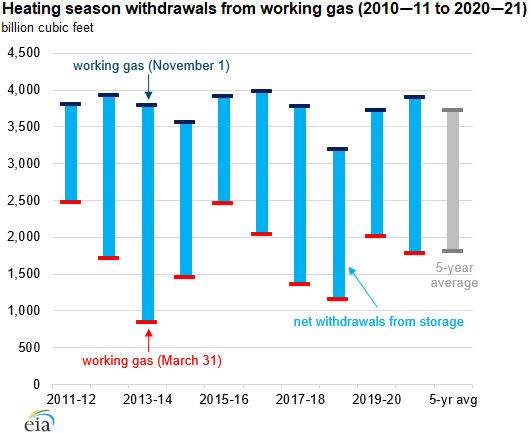 Source: U.S. Energy Information Administration, Natural Gas Monthly and Weekly Natural Gas Storage Report
Source: U.S. Energy Information Administration, Natural Gas Monthly and Weekly Natural Gas Storage ReportNote: Datapoint for March 31, 2021, is an interpolated value, based on the Weekly Natural Gas Storage Report. Data are for the Lower 48 states.
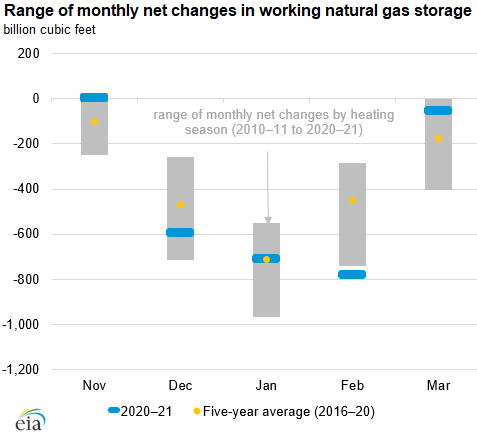 Source: U.S. Energy Information Administration, Natural Gas Monthly and Weekly Natural Gas Storage Report
Source: U.S. Energy Information Administration, Natural Gas Monthly and Weekly Natural Gas Storage ReportNote: Data for February 28, 2021, and March 31, 2021, are interpolated values, based on the Weekly Natural Gas Storage Report.
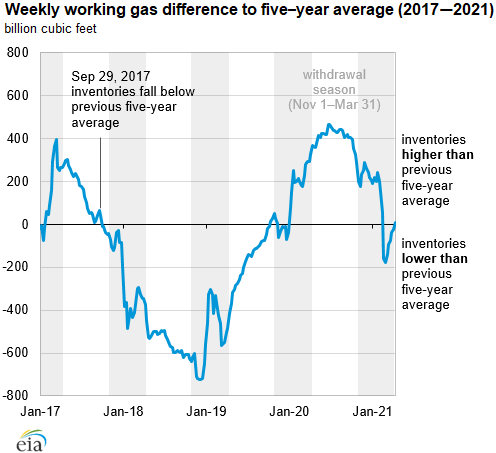 Source: U.S. Energy Information Administration, Weekly Natural Gas Storage Report for week ending April 9, 2021
Source: U.S. Energy Information Administration, Weekly Natural Gas Storage Report for week ending April 9, 2021Note: Data are for the Lower 48 states.
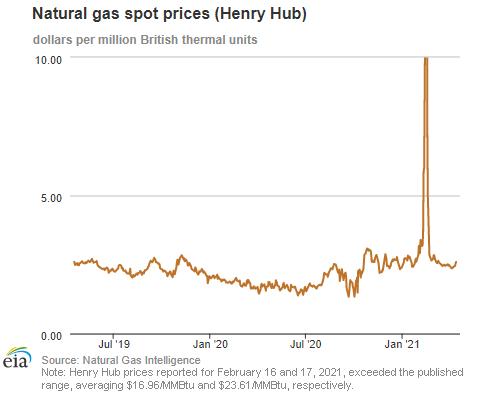
| Spot Prices ($/MMBtu) | Thu, 08-Apr |
Fri, 09-Apr |
Mon, 12-Apr |
Tue, 13-Apr |
Wed, 14-Apr |
|---|---|---|---|---|---|
| Henry Hub |
2.40 |
2.42 |
2.45 |
2.54 |
2.60 |
| New York |
1.79 |
1.67 |
1.86 |
2.03 |
2.25 |
| Chicago |
2.43 |
2.38 |
2.48 |
2.55 |
2.56 |
| Cal. Comp. Avg.* |
2.93 |
2.93 |
3.04 |
3.09 |
3.18 |
| Futures ($/MMBtu) | |||||
| May contract | 2.522 |
2.526 |
2.561 |
2.619 |
2.618 |
| June contract |
2.607 |
2.605 |
2.643 |
2.696 |
2.693 |
| *Avg. of NGI's reported prices for: Malin, PG&E Citygate, and Southern California Border Avg. | |||||
| Source: NGI's Daily Gas Price Index | |||||
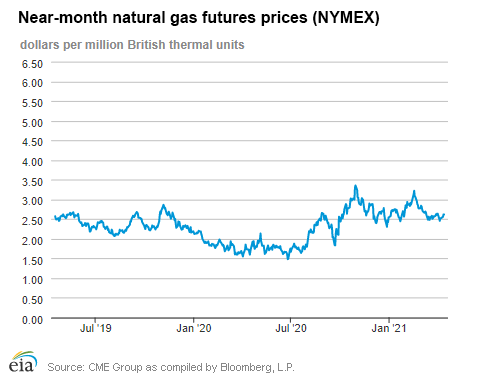
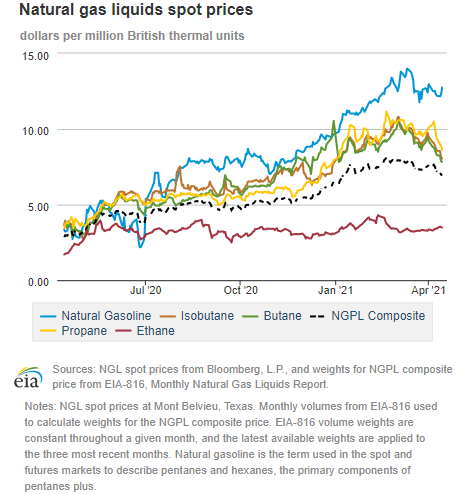
| U.S. natural gas supply - Gas Week: (4/8/21 - 4/14/21) | |||
|---|---|---|---|
Average daily values (Bcf/d): |
|||
this week |
last week |
last year |
|
| Marketed production | 102.9 |
104.0 |
104.0 |
| Dry production | 91.4 |
92.3 |
92.6 |
| Net Canada imports | 3.9 |
4.3 |
4.1 |
| LNG pipeline deliveries | 0.1 |
0.1 |
0.1 |
| Total supply | 95.4 |
96.7 |
96.7 |
|
Source: IHS Markit | |||
| U.S. natural gas consumption - Gas Week: (4/8/21 - 4/14/21) | |||
|---|---|---|---|
Average daily values (Bcf/d): |
|||
this week |
last week |
last year |
|
| U.S. consumption | 64.7 |
67.1 |
67.3 |
| Power | 25.1 |
23.8 |
26.5 |
| Industrial | 22.6 |
23.0 |
21.4 |
| Residential/commercial | 17.0 |
20.4 |
19.4 |
| Mexico exports | 6.5 |
5.5 |
4.4 |
| Pipeline fuel use/losses | 6.2 |
6.3 |
6.4 |
| LNG pipeline receipts | 11.1 |
11.6 |
8.4 |
| Total demand | 88.5 |
90.6 |
86.6 |
|
Source: IHS Markit | |||
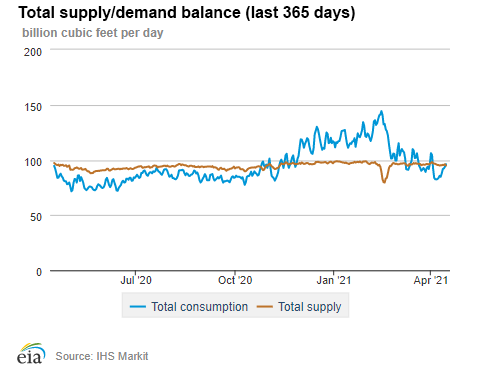
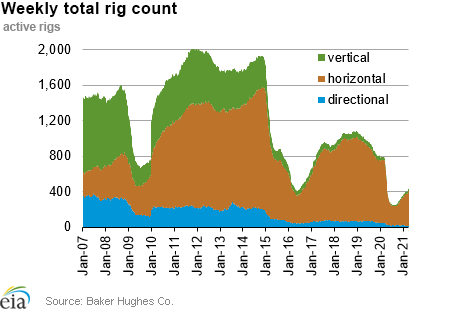
| Rigs | |||
|---|---|---|---|
Tue, April 06, 2021 |
Change from |
||
last week |
last year |
||
| Oil rigs | 337 |
0.0% |
-33.1% |
| Natural gas rigs | 93 |
2.2% |
-3.1% |
| Note: Excludes any miscellaneous rigs | |||
| Rig numbers by type | |||
|---|---|---|---|
Tue, April 06, 2021 |
Change from |
||
last week |
last year |
||
| Vertical | 20 |
0.0% |
-9.1% |
| Horizontal | 394 |
0.8% |
-27.7% |
| Directional | 18 |
-5.3% |
-48.6% |
| Source: Baker Hughes Co. | |||
| Working gas in underground storage | ||||
|---|---|---|---|---|
Stocks billion cubic feet (Bcf) |
||||
| Region | 2021-04-09 |
2021-04-02 |
change |
|
| East | 311 |
305 |
6 |
|
| Midwest | 414 |
398 |
16 |
|
| Mountain | 118 |
115 |
3 |
|
| Pacific | 205 |
198 |
7 |
|
| South Central | 798 |
768 |
30 |
|
| Total | 1,845 |
1,784 |
61 |
|
|
Source: Form EIA-912, Weekly Underground Natural Gas Storage Report | ||||
| Working gas in underground storage | |||||
|---|---|---|---|---|---|
Historical comparisons |
|||||
Year ago (4/9/20) |
5-year average (2016-2020) |
||||
| Region | Stocks (Bcf) |
% change |
Stocks (Bcf) |
% change |
|
| East | 397 |
-21.7 |
303 |
2.6 |
|
| Midwest | 485 |
-14.6 |
398 |
4.0 |
|
| Mountain | 95 |
24.2 |
107 |
10.3 |
|
| Pacific | 203 |
1.0 |
198 |
3.5 |
|
| South Central | 906 |
-11.9 |
827 |
-3.5 |
|
| Total | 2,087 |
-11.6 |
1,834 |
0.6 |
|
| Source: Form EIA-912, Weekly Underground Natural Gas Storage Report | |||||
| Temperature – heating & cooling degree days (week ending Apr 08) | ||||||||
|---|---|---|---|---|---|---|---|---|
HDD deviation from: |
CDD deviation from: |
|||||||
| Region | HDD Current |
normal |
last year |
CDD Current |
normal |
last year |
||
| New England | 142 |
-15 |
3 |
0 |
0 |
0 |
||
| Middle Atlantic | 117 |
-24 |
8 |
0 |
0 |
0 |
||
| E N Central | 81 |
-64 |
-39 |
2 |
2 |
2 |
||
| W N Central | 73 |
-66 |
-58 |
2 |
1 |
0 |
||
| South Atlantic | 75 |
1 |
15 |
8 |
-5 |
-9 |
||
| E S Central | 65 |
-3 |
16 |
4 |
-1 |
-1 |
||
| W S Central | 29 |
-6 |
-9 |
23 |
8 |
1 |
||
| Mountain | 79 |
-49 |
-51 |
12 |
6 |
9 |
||
| Pacific | 55 |
-20 |
-49 |
0 |
-2 |
0 |
||
| United States | 77 |
-33 |
-24 |
5 |
1 |
-1 |
||
|
Note: HDD = heating degree day; CDD = cooling degree day Source: National Oceanic and Atmospheric Administration | ||||||||
Average temperature (°F)
7-day mean ending Apr 08, 2021
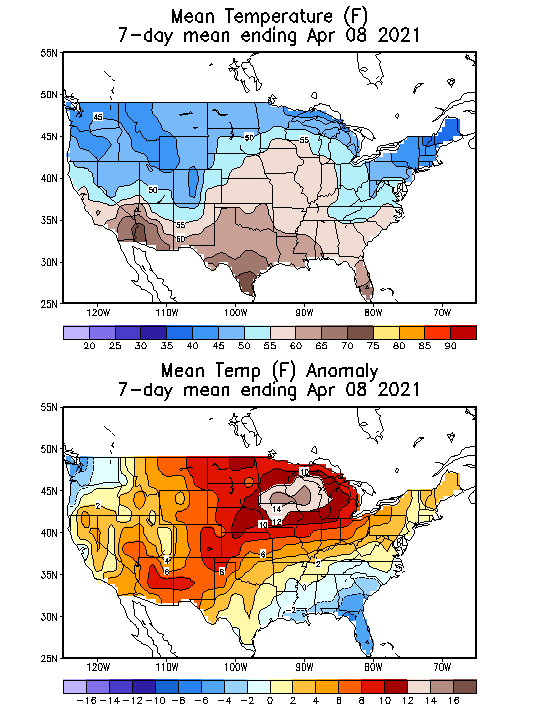
Source: National Oceanic and Atmospheric Administration
Deviation between average and normal (°F)
7-day mean ending Apr 08, 2021

Source: National Oceanic and Atmospheric Administration

